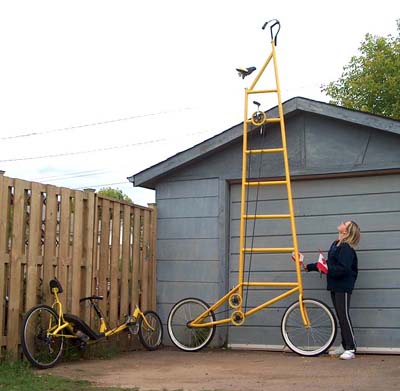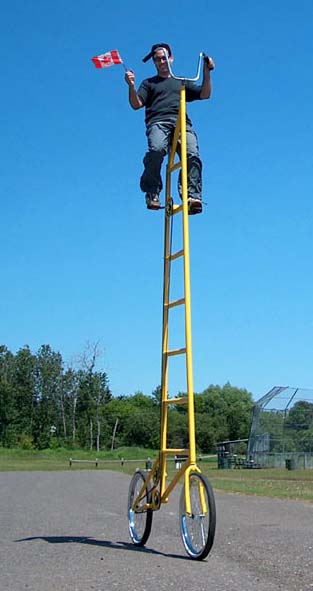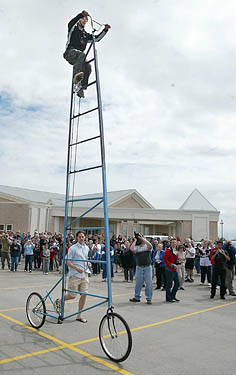January 27, 2005
S&B Foldable Tandem Trike
One of the early pioneers of the modern day recumbent movement, the S&B Recumbent people have a wealth of experience getting people moved around while low to the ground, Besides their popular USS, SWB bikes and all the custom work they do to make other recumbents suit the specialized needs of their customers, they've even pushed the design envelope with their pipe bike. A micro-sized trike that can fit into an 18” hole and expand to less than 48” in height, municipalities are using them to examine as well as fix the inside of pipes buried under their city streets.
 Always defying the standard that are set for two and three wheel propulsion, they are now just about ready to come to the market with their folding tandem trike. Think a trike for two that stores as well as ships to exotic riding turf easily and you will understand why this is a such a breakthrough mode of conveyance
Always defying the standard that are set for two and three wheel propulsion, they are now just about ready to come to the market with their folding tandem trike. Think a trike for two that stores as well as ships to exotic riding turf easily and you will understand why this is a such a breakthrough mode of conveyance
To find out more, keep an eye on their web site
January 26, 2005
The Eye Catching NonaCycle
The Eye Catching NonaCycle

To find out about it and the other wild bike designs produced by Patchwork Central, a faith-based neighborhood outreach organization serving the people of Evansville, Indiana and nearby community, go to: http://www.patchwork.org/bikes/Nonacycle.html.
January 25, 2005
Bullet proof USA made Scarab trike ROX!!

The B&M Enterprises Scarab trike, the frame for which is made by an aircraft manufacturer in Illinois, is one quality machine. Configured with state of the art componentry and assembled with aircraft nuts, bolts and washers, the Scarab has a cult following of well studied owners who feel they are riding the best three wheel bike on the market. Word has it, for example, that none of the wheels come off the ground in a 45 mph, 90 degree turn when hammering on a Scarab! All this for a surprisingly affordable sum, I say do check them out!!!

January 24, 2005
World's Tallest Bike Meets Low Racer

Here are a couple of Canadian Scott Graham's many bicycle creations.

And the tall one was, until recently, the world's tallest. Here
you can see how it evolved to 14 feet, 3 inches.
To see more of Scott's wild bikes, click here
The current world record holder, at 18 feet 2.5 inches, as judged by the Guinness Book of World Records, is Terry Goertzen, a pastor at the Jubilee Mennonite Church in Winnipeg. He rode his skyscraper for 300 metres to earn his spot in the annals of history. It is documented here. But there is only one picture. And sadly the bike is so tall, what they offer is cut off. But I did find the bike you see pictured below at the Salt Lake City Tribune site:.

And Terry is also fascinated with low bikes as per http://bikerodnkustom3.homestead.com/gallery260.html
January 23, 2005
Roads w-o Lights, Lines or Signs Safer?
The Saturday Profile: A Path to Road Safety With No Signposts
January 22, 2005
By SARAH LYALL
DRACHTEN, The Netherlands
I WANT to take you on a walk," said Hans Monderman,
abruptly stopping his car and striding - hatless, and
nearly hairless - into the freezing rain.
Like a naturalist conducting a tour of the jungle, he led
the way to a busy intersection in the center of town, where
several odd things immediately became clear. Not only was
it virtually naked, stripped of all lights, signs and road
markings, but there was no division between road and
sidewalk. It was, basically, a bare brick square.
But in spite of the apparently anarchical layout, the
traffic, a steady stream of trucks, cars, buses,
motorcycles, bicycles and pedestrians, moved along fluidly
and easily, as if directed by an invisible conductor. When
Mr. Monderman, a traffic engineer and the intersection's
proud designer, deliberately failed to check for oncoming
traffic before crossing the street, the drivers slowed for
him. No one honked or shouted rude words out of the window.
"Who has the right of way?" he asked rhetorically. "I don't
care. People here have to find their own way, negotiate for
themselves, use their own brains."
Used by some 20,000 drivers a day, the intersection is part
of a road-design revolution pioneered by the 59-year-old
Mr. Monderman. His work in Friesland, the district in
northern Holland that takes in Drachten, is increasingly
seen as the way of the future in Europe.
His philosophy is simple, if counterintuitive.
To make
communities safer and more appealing, Mr. Monderman argues,
you should first remove the traditional paraphernalia of
their roads - the traffic lights and speed signs; the signs
exhorting drivers to stop, slow down and merge; the center
lines separating lanes from one another; even the speed
bumps, speed-limit signs, bicycle lanes and pedestrian
crossings. In his view, it is only when the road is made
more dangerous, when drivers stop looking at signs and
start looking at other people, that driving becomes safer.
"All those signs are saying to cars, 'This is your space,
and we have organized your behavior so that as long as you
behave this way, nothing can happen to you,' " Mr.
Monderman said. "That is the wrong story."
The Drachten intersection is an example of the concept of
"shared space," a street where cars and pedestrians are
equal, and the design tells the driver what to do.
"It's a moving away from regulated, legislated traffic
toward space which, by the way it's designed and
configured, makes it clear what sort of behavior is
anticipated," said Ben Hamilton-Baillie, a British
specialist in urban design and movement and a proponent of
many of the same concepts.
Highways, where the car is naturally king, are part of the
"traffic world" and another matter altogether. In Mr.
Monderman's view, shared-space schemes thrive only in
conjunction with well-organized, well-regulated highway
systems.
Variations on the shared-space theme are being tried in
Spain, Denmark, Austria, Sweden and Britain, among other
places. The European Union has appointed a committee of
experts, including Mr. Monderman, for a Europe-wide study.
MR. MONDERMAN is a man on a mission. On a daylong
automotive tour of Friesland, he pointed out places he had
improved, including a town where he ripped out the
sidewalks, signs and crossings and put in brick paving on
the central shopping street. An elderly woman crossed
slowly in front of him.
"This is social space, so when Grandma is coming, you stop,
because that's what normal, courteous human beings do," he
said.
Planners and curious journalists are increasingly making
pilgrimages to meet Mr. Monderman, considered one of the
field's great innovators, although until a few years ago he
was virtually unknown outside Holland. Mr.
Hamilton-Baillie, whose writings have helped bring Mr.
Monderman's work to wider attention, remembers with
fondness his own first visit.
Mr. Monderman drove him to a small country road with cows
in every direction. Their presence was unnecessarily
reinforced by a large, standard-issue European traffic sign
with a picture of a cow on it.
"He said: 'What do you expect to find here? Wallabies?' "
Mr. Hamilton-Baillie recalled. " 'They're treating you like
you're a complete idiot, and if people treat you like a
complete idiot, you'll act like one.'
"Here was someone who had rethought a lot of issues from
complete scratch. Essentially, what it means is a transfer
of power and responsibility from the state to the
individual and the community."
Dressed in a beige jacket and patterned shirt, with scruffy
facial hair and a stocky build, Mr. Monderman has the
appearance of a football hooligan but the temperament of an
engineer, which indeed he trained to be. His father was the
headmaster of the primary school in their small village;
Hans liked to fiddle with machines. "I was always the guy
who repaired the TV sets in our village," he said.
He was working as a civil engineer building highways in the
1970's when the Dutch government, alarmed at a sharp
increase in traffic accidents, set up a network of
traffic-safety offices. Mr. Monderman was appointed
Friesland's traffic safety officer.
In residential communities, Mr. Monderman began narrowing
the roads and putting in design features like trees and
flowers, red brick paving stones and even fountains to
discourage people from speeding, following the principle
now known as psychological traffic calming, where behavior
follows design.
He made his first nervous foray into shared space in a
small village whose residents were upset at its being used
as a daily thoroughfare for 6,000 speeding cars. When he
took away the signs, lights and sidewalks, people drove
more carefully. Within two weeks, speeds on the road had
dropped by more than half.
In fact, he said, there has never been a fatal accident on
any of his roads.
Several early studies bear out his contention that shared
spaces are safer. In England, the district of Wiltshire
found that removing the center line from a stretch of road
reduced drivers' speed without any increase in accidents.
WHILE something of a libertarian, Mr. Monderman concedes
that road design can do only so much. It does not change
the behavior, for instance, of the 15 percent of drivers
who will behave badly no matter what the rules are. Nor are
shared-space designs appropriate everywhere, like major
urban centers, but only in neighborhoods that meet
particular criteria.
Recently a group of well-to-do parents asked him to widen
the two-lane road leading to their children's school,
saying it was too small to accommodate what he derisively
calls "their huge cars."
He refused, saying the fault was not with the road, but
with the cars. "They can't wait for each other to pass?" he
asked. "I wouldn't interfere with the right of people to
buy the car they want, but nor should the government have
to solve the problems they make with their choices."
Mr. Monderman's obsessions can cause friction at home. His
wife hates talking about road design. But work is his
passion and his focus for as many as 70 hours a week,
despite quixotic promises to curtail his projects and stay
home on Fridays.
The current plan, instigated by Mrs. Monderman, is for him
to retire in a few years. But it is unclear what a man who
begins crawling the walls after three days at the beach
("If you want to go to a place without any cultural aspect,
go to the Grand Canaries," he grumbled) will do with all
that free time.
"The most important thing is being master of my own time,
and then doing things that we both enjoy," he said. "What
are they? I don't know."
http://www.nytimes.com/2005/01/22/international/europe/22monderman.html?ex=1
107384637&ei=1&en=7948422e3b3a4bb4
Copyright 2004 The New York Times Company
January 06, 2005
World's Fastest Bike with a Shock Absorber

The ZBone by Reynolds Weld Lab
George Reynolds has outdone himself again! In his insatiable quest for speed, he has concocted a bike that according to him is the "best one I ever made". He tells me that it's the fastest bike he has ever produced and this is coming from a man who has made some of the fastest Low Racers on the road today; machines that push even the lightest titanium and carbon fiber road bikes to their performance extremes whenever one asks them for a race. And as it cooks on the flats, it also has a voracious climbing appetite. This he says is due to the Front Wheel Drive he is running on this machine.
And George tells me that by making the bike FWD (pictured at right is a close up of the ZOX FWD that the ZBone uses),

he also can run the seat at the same low levels that he has with his widely respected Low Racers. And to help with the fatigue that breaks any fast rider down, he added a Cane Creek shock over the rear wheel. Weight Penalty with Mounts: 1.5 lbs. All this on a *titanium* recumbent that weighs in at under 23 lbs and not only delivers on acceleration but also on comfort. In fact, if you go to his company website, you will see that they are calling the bike, the X-Bone GTR for Grand Touring Recumbent..
They also offer two wheel size versions. They can be outfitted with either 20" or 700C wheels. And the whole bike travels quite easily as well. Slip the wheels, seat and crank into a wheel bag, then loosen a few bolts and slide the frame into a 36" x 12" x 12" box and it all comes aboard a plane with you at no extra charge as regular luggage.
Framesets start at $2700. $3800 for the complete bike.
January 05, 2005
New Kid Bents for $99!!
Cycological Recumbents has two kid sized Evox Recumbents for sale. Both red and both single speed, they are just a few of the many fine bents you can find at our FREE classified ads